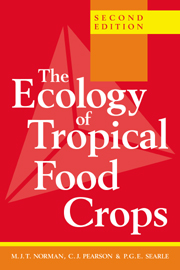4 - Cereals in tropical agriculture
Published online by Cambridge University Press: 05 June 2012
Summary
Introduction
The four most important cereals grown for human food in the tropics are rice, maize, sorghum and pearl millet. There are other minor cereals of warm temperate or tropical origin which are of local importance in the tropics. These include finger millet (Eleusine coracana), a staple food in parts of East and Central Africa; barnyard millet (Echinochloa frumentacea), cultivated in India and southeast Asia; foxtail millet (Setaria italica), grown in parts of India; and teff (Eragrostis tef), which is confined to the Ethiopian highlands.
The temperate cereals wheat and barley are also grown to a limited extent in the tropics, largely at high altitudes: for example, wheat in Kenya and barley in Ethiopia. Wheat and barley are important crops in the Indian subcontinent, and are grown there in the cool season at low altitudes, but the bulk of the crop area lies outside the tropics.
Regional production
Table 4.1 gives the area, yield and production of cereals in the tropics, and is approximate in two aspects. First, in the FAO data from which it is derived pearl millet is conflated with finger millet, barnyard millet, foxtail millet and proso millet (Panicum miliaceum) under the general title of ‘millets’, and in some countries millets are reported together with sorghum. Second, the definition of the tropics is not exact, in that the data are available only on a national basis and some important cerealgrowing nations straddle the tropics.
- Type
- Chapter
- Information
- The Ecology of Tropical Food Crops , pp. 87 - 99Publisher: Cambridge University PressPrint publication year: 1995



